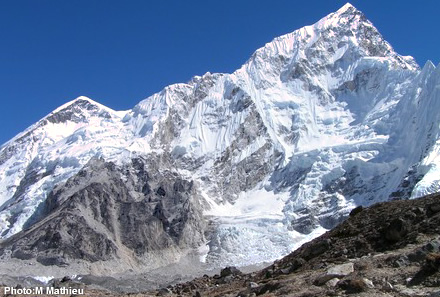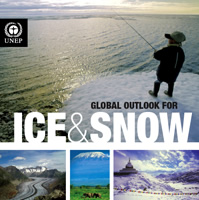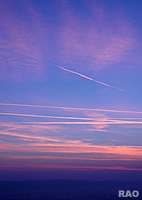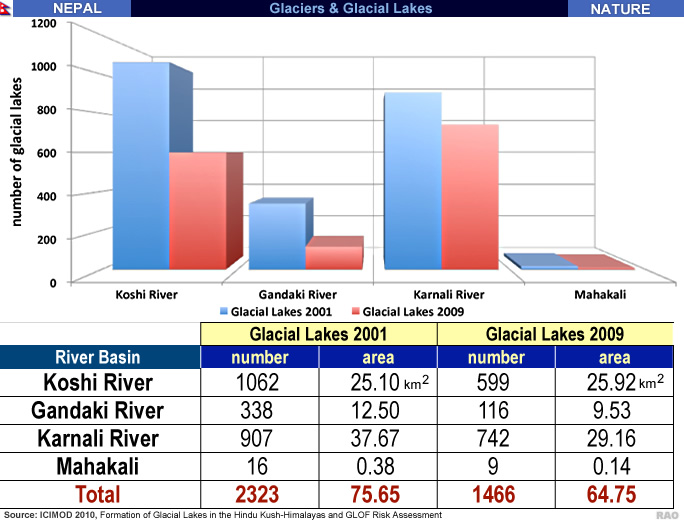 |
Nepal Himalayas Glaciers |
|
 |
Nepal Information |
|
|
 |
|
Fast
Melting Glaciers from Rising Temperaturesto
Devastating Floods and Water Shortages
|
 |
The
rapid shrinking of Himalayan glaciers, accelerating at alarming rates in
past decades as a result of global warming, will have catastrophic consequences
for communities living downstream and millions who rely on glacial melt
water, a new report says.

|
|
The
report, the first comprehensive study on the impact of warming temperatures
on glaciers and glacial lakes in the Himalayan region warns of impending
glacial lake outburst floods (GLOFs) - when rising waters from glacial
melt breach dams in glacial lakes - and calls for early warning and mitigation
measures to avert disaster.
Nearly
15000 glaciers and 9000 glacial lakes are found in the Himalayan mountain
chain which stretches 2500 km across five countries - Bhutan, Nepal, Pakistan,
India and China.
|
|
The mountain range feeds nine perennial river systems
in the region and constitutes a lifeline for nearly 1.3 billion people
downstream.
Himalayan
glaciers are shrinking at an average of 10 to 60 m annually, with some
retreating by 74 m a year. In China, glaciers have been retreating at a
rate of 5.5 per cent in the last three decades. With current climate change
projections two-thirds of China's glaciers are likely to disappear by 2050,
and almost all would be gone by 2100.
Significant
changes were also seen in the Indian Himalaya, with the highest rate of
glacial retreat found in the Bada Shigri Glacier and lowest in the Chhota
Shigri Glacier in the Chenab River Basin, where glaciers are retreating
by 6.8 to 29.8 m each year.
In
Bhutan, the Luggye Glacier retreated by 160 m yearly from 1988 to 1993
resulting in rapid growth of the Luggye Tso Lake. The Raphstreng Glacier
retreated 35 m every year on average from 1984 to 1998 but from 1988 to
1993 the retreat rate almost doubled to 60 m per year.
Glacier
retreat has been accelerating in Nepal since the 1990s, with dramatic retreats
recorded between 1994 and 1998 especially in the Dudh Koshi sub-basin where
all of the glaciers studied have retreat by 10 to 59 m yearly. The Dudh
Koshi sub-basin is the largest basin and most densely glaciated region
in Nepal.
Melting
glaciers are also leading to some of the fastest-growing glacial lakes
in the region. Some glacial lakes have grown by almost 800 per cent since
the 1970s.
 |
|
Glaciers
flowing down from Annapurna I |
Nepal
and Bhutan have the highest concentration of glacial lakes with 20 potentially
dangerous lakes in Nepal and 24 in Bhutan. Of this, Lake Imja Tso in the
Dudh Koshi Basin in Nepal, home to Mount Everest and one of the most popular
tourist destinations and trekking route is among the most hazardous.
"Communities
and businesses are still reeling from the devastating 1985 Dig Sho GLOF
which is also found in the same basin. We anticipate that the impact of
a GLOF in Imja Sho will be six times greater, and will extract a heavy
toll on heavily populated settlements downstream, not to mention the devastation
it would bring to infrastructure and agricultural lands. There will be
a high human and economic cost," said Surendra Shrestha, Regional Director
of the UNEP Regional Office for Asia and the Pacific.
Glacial
floods are a regular occurrence in the Himalaya region with varying degrees
of socio-economic impact. Their impact can be quite extensive since they
destroy villages, agricultural lands, roads, bridges, hydropower, trekking
trails as well human lives and property. The Tibetan Zhangzhangbo GLOF
in 1981 caused extensive infrastructural damage and nearly US$3 million
in losses. The Dig Tsho GLOF in Nepal in 1985 destroyed a power plant (with
a loss of US$1.3 million), destroyed homes and lands and many losses of
lives. The Luggye Tso GLOF in Bhutan in 1994 damaged sacred areas, cultivated
land and lives.
The
Hindu Kush-Himalaya glaciers are also an important source of freshwater
for hundreds of millions of people living downstream. Glacial retreat is
also causing long term loss of natural water storage of fresh water.
"The
significance of these glaciers to downstream communities is of particular
importance. Changes in glacier ice or snowmelt affects water yield to downstream
regions heightening the risk of water shortages, impacts irrigation water
for crops and may disrupt industry and power generation," said Dr. Andreas
Schild, Director General of the International Centre for Integrated Mountain
Development.
"We
have to continue monitoring glaciers and glacial lakes to ensure sound
management of these valuable water resources. In addition, the use of early
warning systems like satellite-based techniques and mitigation measures
such as dam breach and hydrodynamic modeling are important to reduce risks
to vulnerable mountain populations," Shrestha added.
 |
| Source:
United Nations Environment Programme UNEP June 2007 |
top
|
UNEP
Report 2007: «Global Outlook for Ice and Snow»
|

|
| UNEP-Report
2007 |
UNEP |
 |
 |
| 77.4
MB PDF-File (english version) |
 |
 World
Meteorological organisation WMO World
Meteorological organisation WMO
 United
Nations Environment Programme UNEP United
Nations Environment Programme UNEP |
|
 |
|
more information
|

|
 |
| PHOTO GALLERY |
Bhutan - Nepal |
|
|
| Links |
 |
 |
 |
External
link |
 |
UN
Environment Programme (UNEP)
UNEP |
|
|








